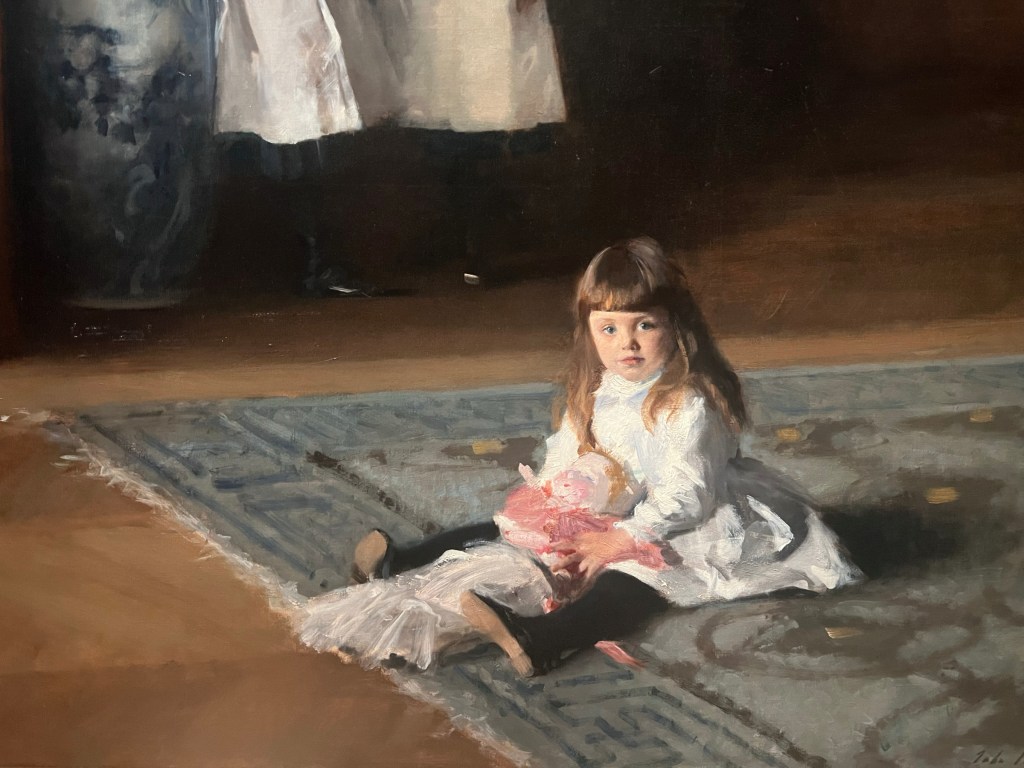The Tender Specificity of John Singer Sargent


John Singer Sargent was just 18 when he arrived in Paris in 1874. In the ensuing decade, he would not only launch his career as a painter, exhibiting and earning accolades at multiple salons, but also embark on travels that would permanently inflect his practice and establish the connections that would fund his work, including upper-crust socialites, athletes, and financiers; writers like Henry James; and artists like Monet, Renoir, and Rodin. Portraits of and by many of those very figures are on view in Sargent and Paris at the Metropolitan Museum of Art. Indeed, what comes through most strongly in this exhibition is his humanistic bent: Sargent loved people, and it shows.
The exhibition’s structure is fairly straightforward, even a bit basic, with section titles like “In the Studio,” “Beyond the Studio,” and “Fascinating Portraits,” but the works speak for themselves. The first two sections focus on Sargent’s education, notably under the French portraitist Carolus-Duran, as well as his travels around Europe and North Africa. Even in these early years of adulthood, the hallmarks of his talent begin to show. Though his copies and academic drawings, such as “The Dancing Faun, After the Antique” (1873–74) are stiff, lacking that living spark, paintings like “A Male Model Standing before a Stove” (c. 1875–80) are imbued with human specificity. The model’s body is unidealized, with protruding ribs and a slight paunch; he gazes at the floor, as if deep in thought. Notably, Sargent depicts the screen behind which the model changed as well as the stove he used to stay warm, emphasizing that this is a real person in the world, a quality that persists in later portraits.

Indeed, it’s in painting people that Sargent really shines, and he makes them shine too. They are almost always depicted asymmetrically, and captured mid-movement, as if to underscore that they surpass the boundaries of the frame. For instance, “Portrait of Frances Sherborne Ridley Watts” (1877), which marked his public debut when it was shown at the Paris salon, seems to capture this family friend shifting in her seat, the buttons of her dress snaking sinuously around her body. “The Sulphur Match” (1882) is a moralizing genre painting, in this case a warning against the dangers of drinking, but the tender specificity of the figures — the woman’s feet perched up on a chair titled precariously back, held in delicate balance by her fingertips only — transcends its container.
For Sargent, life is found in the hands, and he renders them better than just about anyone. See, for instance, the dashing “Dr. Pozzi at Home” (1881), enrobed in splendorous red. His right index finger and thumb clasp his garment shut while the other three fingers splay out energetically across his breast; two fingers of his other hand hang off a string at his hip. One of Madame Ramón Subercaseaux’s hands in her 1880 portrait grasp at the post of her chair, her index finger curled as if its pad were feeling its polished surface; the other is poised casually against the frame of a piano, her fingers about to slip off the keys. Here, as in all of Sargent’s portraits of high society, his sitters are surrounded by the trappings of their wealth, but not entrapped or even burdened by them, as in many other paintings showing off riches, like those by Thomas Gainsborough or Anthony van Dyck. Madame Subercaseaux’s piano is interesting only insofar as it’s scaffolding for her elegance, as is that fine silk and that gilt ring.

Sargent extends this grace to children as well, capturing the peculiar way that they stare, having not yet learned that it’s rude. “Edouard and Marie-Louise Pailleron” (1880) is a particularly arresting example — he apparently clashed with then-11-year-old Marie-Louise over her clothing and pose across supposedly 83 sittings, and her headstrong personality shows in her forthright gaze. Her brother’s right arm is torqued, his hand resting on its back — a favored position for Sargent, it seems — natural for its very unnaturalness. In all these portraits, the sitters’ hands emphasize their restlessness — these people aren’t trapped within this frame forever; they’re here for just a minute or two before they dash back to their own busy and interesting lives.
This show fittingly culminates with “Madame X” — perhaps the greatest work of Sargent’s career and an icon of The Met’s collection — as the controversy that arose from its showing at the Paris Salon in 1884 may have in part prompted him to leave the city. The background is an undifferentiated tan. The subject wears no jewelry, and the low table at her side serves only to prop up her alabaster arm, which leads you up around that elegant, unadorned neck to that proud, almost imperious profile. Here is a woman unabashed in her beauty, a woman who knows that her portrait is worth painting. This is what Sargent captured in his paintings: that beautiful particularness of each of us.








Sargent and Paris continues at the Metropolitan Museum of Art (1000 Fifth Avenue, Upper East Side, Manhattan) through August 3, and will travel to the Musée d’Orsay (Esplanade Valéry Giscard d’Estaing, Paris, France) from September 23 through January 11, 2026. The exhibition was organized by the Metropolitan Museum of Art and Musée d’Orsay. It was curated by Stephanie L. Herdrich, Caroline Corbeau-Parsons, and Paul Perrin, with Caroline Elenowitz-Hess.
The complementary exhibition Emily Sargent: Portrait of a Family will be on view at the Metropolitan Museum of Art from July 1 through March 8, 2026.





